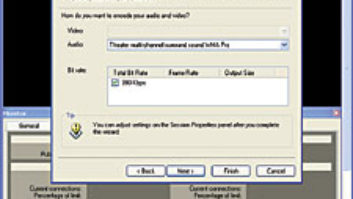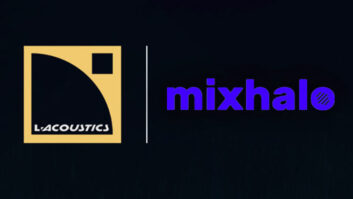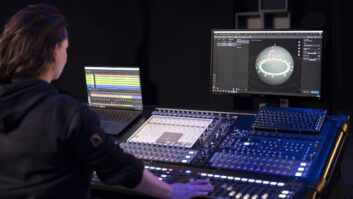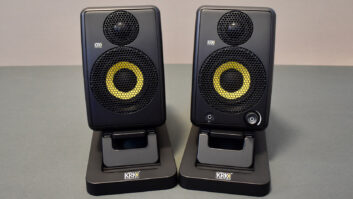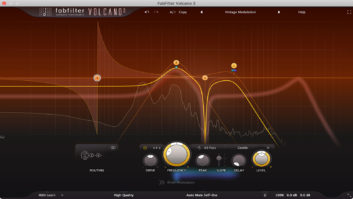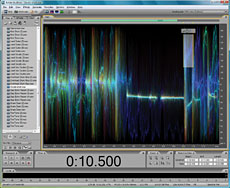
In the Spectral Pan display, colors can be used to identify various audio characteristics, such as frequency, panning and amplitude.
Adobe Audition has an impressive lineage, going back to its 1995 roots as Syntrillium Software’s Cool Edit program. A shareware version of the full-on Cool Edit Pro, Cool Edit was one of the most popular PC audio editing programs and developed an exceedingly loyal following over the years. So when Syntrillium’s assets were acquired by Adobe in 2003, there was some concern that the program — rechristened as Adobe Audition — would be neglected or disappear.
Thankfully, this has not been the case. In fact, just three weeks ago at the IBC broadcast show in Amsterdam, Adobe continued its commitment to this audio software with the unveiling of the third-generation Audition 3. The program doesn’t officially ship until Q4 2007, but we got a sneak preview of a late beta version, which was fairly close to the genuine article, save for some (mostly) cosmetic tweaks.
MAJOR MULTITRACK EDITING
Perhaps one of Audition 3’s strongest suits is the ease with which it edits multitrack files. Combining/comping multichannel drum tracks from different takes or re-using a verse or chorus section can be problematic, simply due to matching slight volume changes or leftover decays from cymbal hits, etc. Audition 3 allows you to convert any number of tracks into clips, make the standard cut/copy/paste moves and then assign crossfades (automated or manual) across two multitrack clips. Once done, “handles” on either side of the transition can be pulled in either direction to tweak the edit point; dragging the (linear or nonlinear) crossfade envelopes creates a seamless edit across all grouped tracks.
TOPS AND TAILS
On the 2-track side, Audition 3 adds Top/Tail Views, a clever new mode for zooming into a file where only the beginning and end of a section are magnified, while the view of the center portion remains small. In music editing, this could provide a detailed look at a song’s head and ending, where the relative levels of the files (or fade lengths, etc.) can be visually compared within a screen view. This feature has obvious appeal in other apps, such as mastering or dialog/voice-over editing.
SPECTRAL EDITING
One intriguing and useful feature in Audition 3 lets you select problem areas within a frequency display window and use the Spot Healing Brush to eliminate noises, like pops and clicks. This power is taken to the next step in the Spectral Pan display, which applies colors to the onscreen file to identify various characteristics of the sound, such as frequency, amplitude, panning and phase. An offending sound — i.e., a distant car horn during a dialog take or a squeaky piano bench — can be quickly isolated based on any of those colorized parameters and eliminated without disturbing adjacent frequencies. In fact, a Spectral Bitmap option even lets users export the screen file to Adobe Photoshop, make the change and import the result back into Audition 3.
For unwanted sonic problems that evolve over time, Audition 3 adds an adaptive noise-reduction tool that intelligently removes noise, while automatic phase correction can calculate and apply the optimal delay to align stereo waveforms. And a graphic panner function looks at two channels and corrects any frequency-dependent phase differences.
INSTRUMENTALLY YOURS
Audition 3 adds full support for VSTi virtual instruments, as well as a MIDI sequencer with a piano roll-style editor for tweaking note, velocity or controller values. And keyboard players don’t get all the fun: Although not exactly a typical feature in most audio editing programs, Audition 3’s Guitar Suite offers analog guitar amp/effects modeling with filters, compression, distortion and cabinet modeling.
DSP AND BEYOND
In all, Audition 3 provides more than 50 DSP tools and effects, mastering and analysis tools and audio restoration features, in addition to supporting third-party VST and DirectX plug-ins. Along with old favorites — such as echo, flange, graphic and parametric EQs — are new effects, including a tube-modeled compressor, analog delay and a Surround Encoder for exporting a multitrack mix as an interleaved file for use with Adobe Premiere Pro.
Highlights in the new DSP goodies department include a convolution reverb and radius time stretching. Developed by iZotope, the latter applies a high-quality time expansion/compression algorithm that allows you to change tempo accurately without changing pitch, or alter pitch without tempo distortion.
THE FINE PRINT
Audition 3 offers a lot of power, but needs a decent PC to back it up. Minimum system requirements include an Intel Pentium 4 (1.4 GHz for DV, 3.4 GHz for HDV); Intel Centrino; Intel Xeon (dual Xeon 2.8GHz processors for HD); or Intel Core Duo or compatible processor (SSE2-enabled processor required for AMD systems) and at least 512 MB of RAM, with 1 GB for DV playback, 2 GB for HDV and HD playback.
A major upgrade optimized for both Windows XP and Vista with tons of new features, Audition 3 is a powerhouse — a serious audio tool by anyone’s standards, especially at its projected street price of $349. Upgrades are also available for existing Audition owners.
For more information, visit www.adobe.com/audition.

